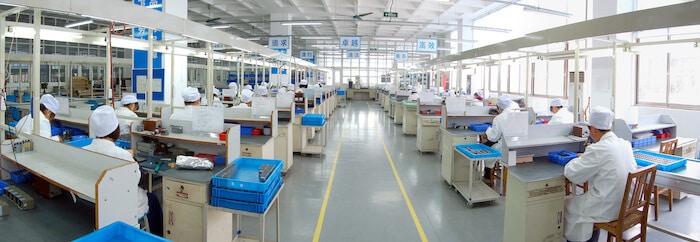One of the most important decisions you can make when launching a new product is where your product is manufactured and who your manufacturing partner is. And let’s be honest, the pandemic and supply chain disruptions in recent years might make you question if manufacturing in China is still the obvious choice it may have been before all this change.
You should be asking a very specific question: Is China manufacturing the right solution for your company and your product?
Remember, news sites are interested in click bait and how to get your attention. They are not going to write an article about how Chinese manufacturing is as diverse as the country itself. Nor will they write about how, regardless of politics, tariffs, lockdowns, and congested ports, success with any manufacturer is about building the right team, communicating, and adapting when things change. But we love to get into the nitty-gritty and look at the nuanced reality of what is happening on the ground because we are on the ground every day, working with customers like you.
So let’s put away the broad brush that non-manufacturing people want to paint the situation with. In this article, we will look at the situation on the ground, provide some suggestions on how to figure out if China is a good fit, and if so, how to drive your production there towards success.
Some Facts About China Manufacturing

From an all-time high of $538 billion in 2018, the value of goods imported from China to the U.S. dropped from $451 billion in 2019 to $435 billion in 2020 in a year dominated by the pandemic and shutdowns across the world. That trade recovered in 2021 to $506 billion. The first quarter of 2022 saw a 21% increase compared to the first quarter in 2021. Manufacturing in China for the U.S. market is not going down, it’s going up. China is now seeing good economic growth.
What has changed for the negative is the predictability of when your products ship and how long it will take for your products to get to and through U.S. ports. And, regardless of what your spouse’s uncle spouts off at a family gathering, it’s not caused by one of the conspiracies he shared. The slowdown is caused by, amongst other things:
- Shortages of raw materials
- Power shortages in China
- Delays in making component parts
- A global chip shortage
- Labor shortages caused by increased demand
- Labor shortages caused by lockdowns from China’s zero-COVID policy
- Backed-up ports caused by increased demand, labor shortages, and shutdowns
- Empty shipping containers in the wrong place
- Overcrowded ports in the U.S.
- A shortage of trains and trucks to distribute the goods in the U.S.
Many of these root causes feed on each other. The chip shortage in Shanghai might impact a factory that makes components in Shenzhen that can’t make an order to your supplier in Hong Kong. The good news is that it’s getting better over time, and people who focus on the manufacturing sector know what to look for now.
At the same time, there are positive changes across the manufacturing sector in China. Manufacturers are redoubling their efforts to improve their quality assurance and move manufacturing inland where labor costs are lower. They’re investing in digital manufacturing like digital manufacturing systems, Industry 4.0 initiatives, and robotics and other automation. As companies like Tesla are discovering, improvements in engineer talent, especially around electro-mechanical systems, are taking Chinese suppliers up the value chain to providing design and engineering to complement their already robust manufacturing capabilities. On top of that, the Chinese domestic market continues to expand, creating a more robust and diverse manufacturing base.
Is China Manufacturing Right for Your Products?

First, take a look at your product and your market and decide what you need now, and what you need in the long run. Sit down with your team and outside experts and think about the importance of the following:
- Time to market from product launch to product availability
- Cost of shipping
- Sensitivity to up-stream supply chain disruptions
- Production cost
- Importance of a steady, predictable monthly production
- Impact of delays on your brand and cashflow
- Quality
Your industry or company may have more issues that need to be addressed. Talk them out and write them down. When you’re weighing the pros and cons of production in China vs. places like Vietnam, Taiwan, Mexico, or domestically, you can compare and make a smart decision.
Things are a little crazy now. Until COVID-19 fully subsides, you will probably have to deal with more lockdowns. The war in Ukraine is going to impact the availability of raw materials like plastics and metals. And these factors will impact China differently than in other countries because of their zero-COVID policy and where China sources its raw materials. Don’t make a decision that will hurt you in the long run because of these shorter-term issues. A slow launch may be OK if you are ramping up production over three years. Or maybe your product is something that is hot right now and you need to get inventory immediately and sell your way through it quickly. The first is a reason to work with Chinese production partners, and the second is a reason to look at other options.
If the capabilities and costs of a supplier you have found look good, and you can live with disruptions, China may be the right fit. Only you and your team can make that decision. And even though these current disruptions will pass, there will be new shocks to the system in the future. Climate, new viruses, and geopolitics have a lot of tricks up their sleeves. If China is right for you now, it probably will be when the next global derailment happens.
Suggestions for Getting China Manufacturing Right

Remember, we are putting away that broad brush. There are thousands of contract manufacturers in the country, and each is unique. Here are some guidelines for finding the right manufacturer:
- Make a list of questions you want to ask each potential partner, and always ask them
- Get to know the company beyond the sales representative
- Identify the manufacturing technology needed for your product and make sure they have it available
- Look for a partner who is implementing new automation technology or moving labor-intensive operations inland
- Understand what they will need to subcontract and evaluate them
- Ask and understand how robust their supply chain is
- Get a handle on your quality needs and their quality capabilities
In addition to these common steps you should take with every Chinese manufacturer you evaluate, there are some specific steps for finding the right supplier in China:
- Investigate how much total volume they do to see how much clout they have with their suppliers
- Understand what it will it take to get your products from your factory to a port
- Try to get a feel for how connected they are in the local manufacturing community and with the local government
- Ask them about their capital situation, how long can they survive if there is a lockdown
- Ask about employee turnover, and specifically ask how many of their workers returned after the Chinese New Year.
- See if they use machinery and automation, including robots, to be less vulnerable to labor shortages and lockdowns
Remember, you can work with a sourcing agent to help with this process.
Once you have the right partner, sign the contracts, and transfer the design information, it’s time to start making your product. No matter how good your choice was, there is still work to be done to make sure you get it right.
Here are some suggestions to get Chinese manufacturing right:
1. Plan for Delays
Delays are part of production now, and even when they go away, they can always come back. Assume that there might be delays and develop alternatives and set up your supply chain so any single delay doesn’t muck things up too much.
2. Invest in Inventory Upstream and Down
Build up a buffer of inputs for your product as well as for the product itself. Inventory costs money; it’s an asset sitting somewhere not generating revenue. This is especially true for any inputs to your product that have to come from other parts of China or from other countries. But, if you keep a reasonable amount of inventory available, delays and constrictions won’t impact you as much.
3. Pay on Time
When it’s crunch time and your Chinese manufacturing partner is trying to decide where to allocate their resources, they are going to prioritize the customers who pay them on time. In unsettled times cash flow can become a problem for your Chinese manufacturer, and being on time with payments helps them help you.
4. Build a Good Relationship With Management Across the Factory
Get to know the people who run the factory in China — production, quality, and supply chain. If you have a relationship with them, they are more likely to let you know about problems before they get worse, and when there is a problem they will work harder to find a resolution. Personal relationships are important in Chinese culture and business. Use that to your advantage.
5. Be Involved and Present With Your Manufacturing Team
You need to know what’s going on, good and bad. Be engaged with your team so you are aware of what they are happy about, what they are worried about, and what has them stressed out. Help them make decisions from the perspective of your business goals.
6. Forcast, Revise Your Forecast, and Keep It Updated
One of the most important tools for all of the suggestions above is a good forecast. Work with your team, your outside experts, and your Chinese manufacturing partner to create and maintain an accurate forecast so all of you can plan and adapt.
Most of these are really about paying attention and building a good relationship, nothing unique to China. What makes it different is how it occurs within the context of what is going on in China while you are making your products, and how global events impact the country and your manufacturer.
Build a Plan for Manufacturing Success

And the best way to make a great plan, and for that matter to find the right manufacturing source in China, is to work with the experts at Gembah. Not only is this what we do all day, across industries, and around the world, but we have a robust marketplace of independent experts who can be part of your team to find the right solution for your product.
Let us help you make the decision on manufacturing location and then implement your production plan. Reach out now and let’s talk about what you want to accomplish.



